TABLE OF CONTENTS
Have you ever wondered what makes one computer a ‘Workstation’ and another, a ‘Gaming’ PC? Surely, it can’t just be the RGB (or lack thereof).
You often hear manufacturers promote their latest product as ‘the best in the gaming market,’ but then you see them listed in professional setups. What’s that about?
The world of PC hardware includes a vast array of terminology. Hence, finding minor differences between various types of hardware, like those used in workstations and/or gaming PCs, can get really confusing at times.
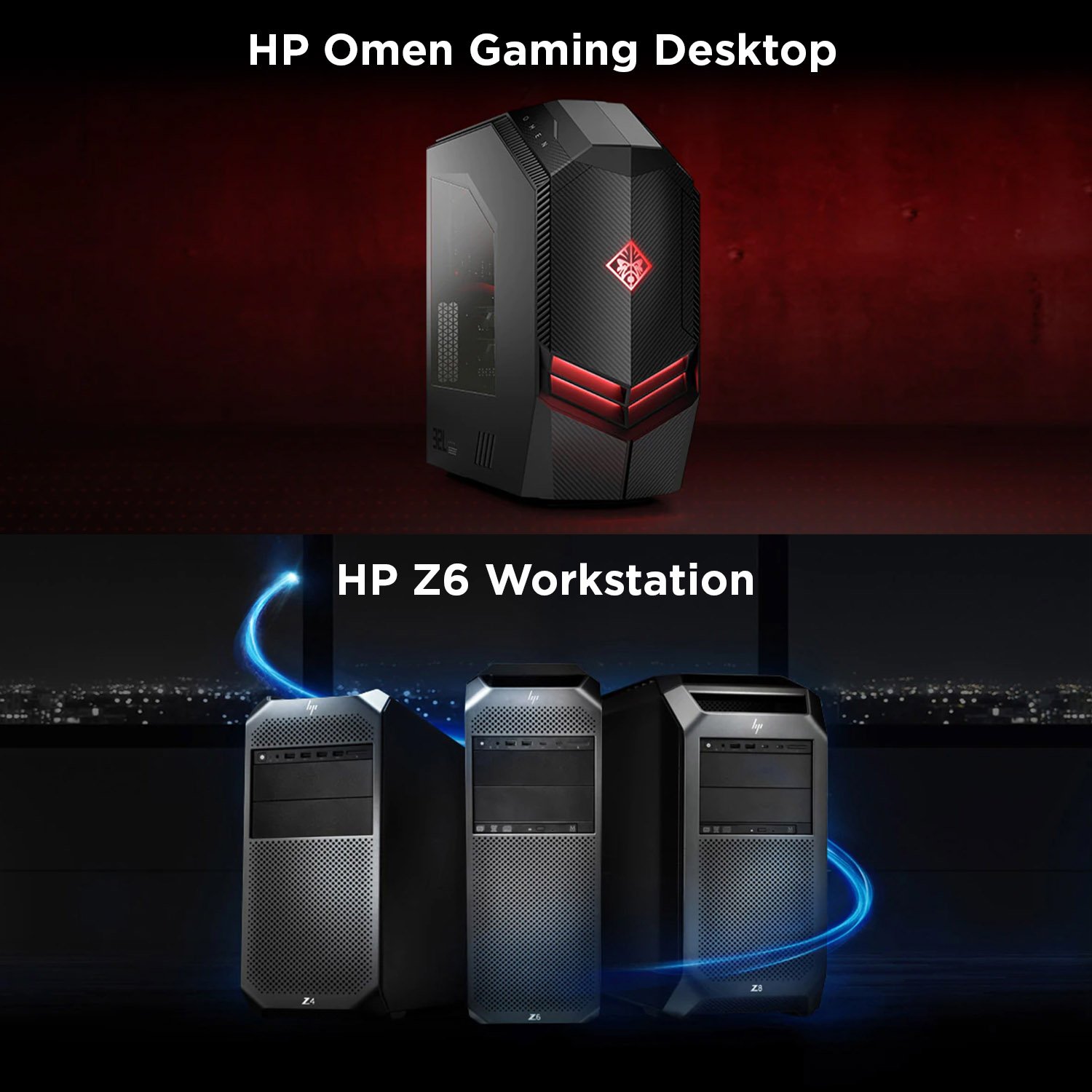
In this article, we’ll be looking at what differentiates workstations and gaming PCs and the hardware that goes inside them. We’ll also go over guidelines to choose the correct archetype to base your next build on.
Reaching a Definition
Finding the line that separates a workstation from a gaming PC is harder than you’d expect.
You might think – it’s simple, the workstation is for work, and a gaming PC is for gaming. Right?
Perhaps a decade ago, this would be true, but it’s really no longer the case.
Hardware that manufacturers market to gamers has become incredibly powerful and can be used just as well for workstation applications like CAD, 3ds Max, or DaVinci Resolve.
Why It’s Not Black & White
While Wikipedia defines a workstation as “a special computer designed for technical or scientific applications,” anyone can make this ‘special’ type of computer by using regular hardware that’s marketed to gamers. For example, you can use mainstream components like the AMD Ryzen 9 5950X processor or an Nvidia GeForce RTX 3090 graphics card.
But does this mean that consumer products outperform their professional counterparts? If so, in what aspects? Why do many professionals gravitate towards them?
An Analogy
Think of it this way: professional Formula One cars can reach a top speed of about 250 miles per hour. But a Bugatti Chiron SS, which anyone can buy if you have the money, can reach 273 MPH!
So, in one aspect, i.e., top speed, the F1 car is outperformed, sure. However, it holds a crucial and practical advantage in other significantly important tasks, like turning or break-speed.
Add to this the quality of materials & custom components that fit FIA specifications, and it’s no wonder the F1 car can cost more than three times the Bugatti’s selling price – just in parts!
Workstation Hardware vs. Consumer Hardware
This is kinda-sorta the case for workstation parts as well.
Consumer hardware can often outperform them in professional workloads at a certain price point, but workstation hardware is purpose-built for running professional software. So, they come with a host of certifications and driver-level optimizations that may give them an edge in targeted workloads.
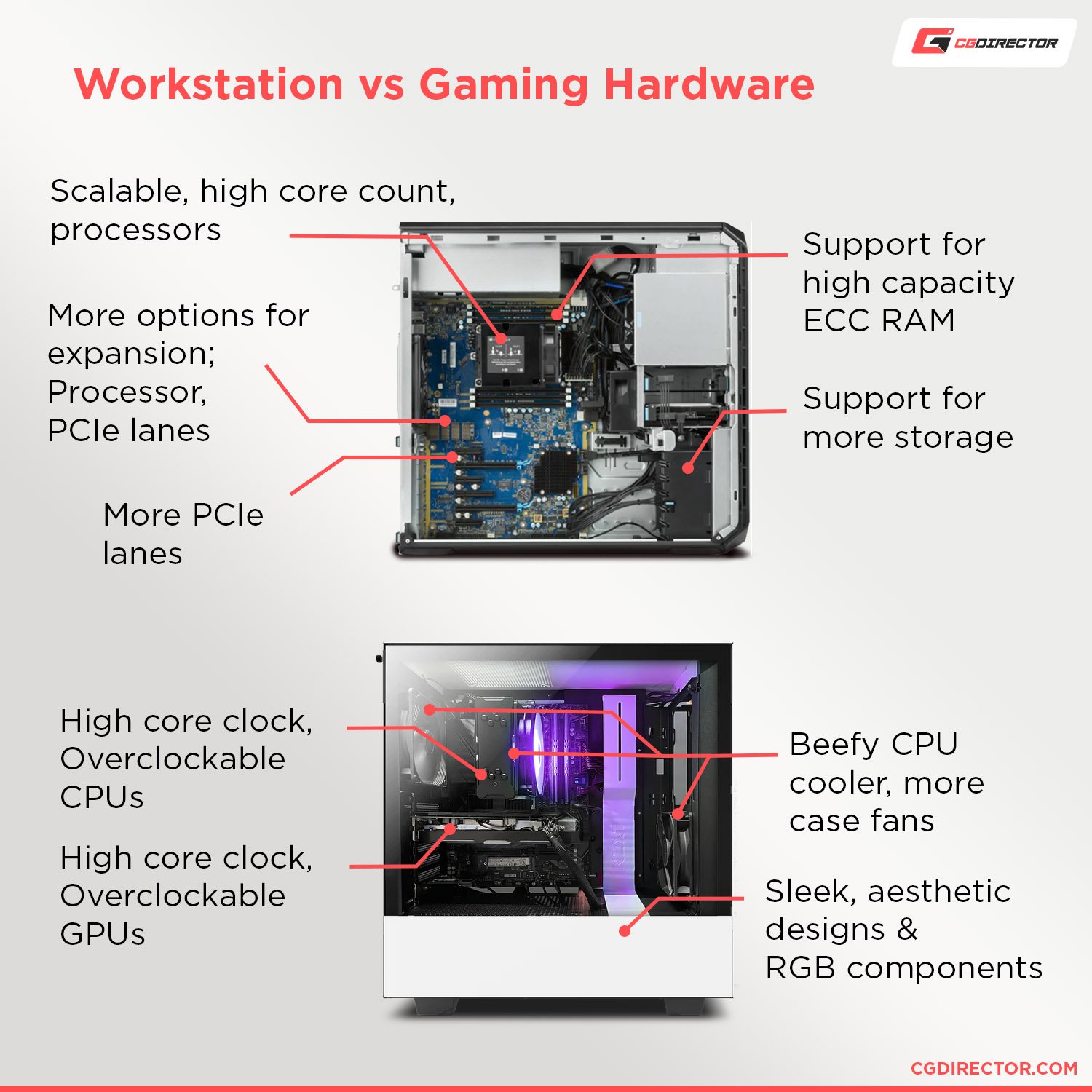
These are just some features that make them so much more expensive than consumer-grade hardware. But it is these optimizations that are paramount for some professionals, yet unappealing to others who will prefer better price-performance ratios.
For a more in-depth take on a specific component like the graphics card, check out our article listing the differences between professional and consumer GPUs.
Defining the Workstation, and Gaming PC
Performance is not the only aspect that differentiates a workstation and a gaming PC.
Let’s look at what other factors we need to consider and how to define each build.
Workstations
A professional-grade product will always be built for a specific purpose.
When it comes to PCs, this means handling applications that are important to professionals who deal with production, content creation, and more.
Independent Software Vendors (ISVs), like Autodesk, Siemens, and Adobe, are crucial to the design and creation of such hardware.
ISV Cooperation
The manufacturers of professional-grade components work closely with ISVs, to ensure that their products (hardware and software) synergize with the ISV’s application.
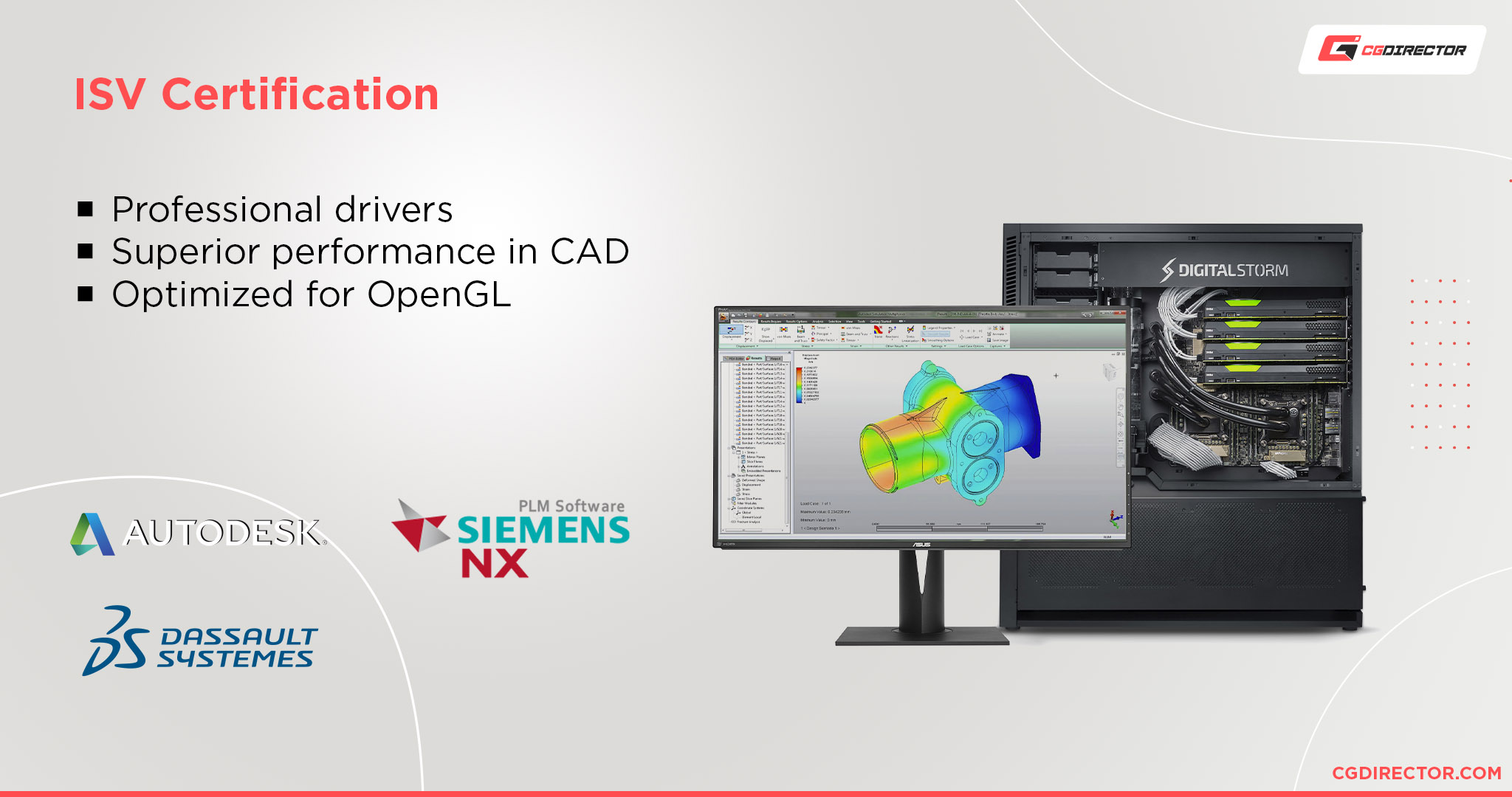
Because of this cooperation, professional components will often be certified by the ISV, ensuring compatibility and excellent performance.
If you ever need ISV support for a hardware component, then whether or not you receive it, will most likely depend on whether the parts you’re using are certified by them or not.
Operating System & Specialized Software
The operating system and software of a workstation can also be tailor-made for a specific audience.
For example, Windows has a separate version of its Windows 10 OS that’s designed for workstations (Windows 10 for Workstation), which includes features like ReFS (Resilient File System), SMB (Server Message Block) Direct, and NVDIMM-N (Non-volatile Dual In-line Memory Module) support.
ISVs may also have certain software features locked away from consumer software/OSes, citing compatibility issues.
For example, you can only use technologies like SolidWorks’s RealView Graphics only when you’re using a workstation GPU like Nvidia’s Quadro/AMD’s Radeon Pro.
Although this might seem arbitrary, this differentiation is understandable from their perspective. Even online services like Dropbox will differentiate between Individual, Pro, Business, and Enterprise – providing different services, features, and customer support for each level.
In general, a workstation will often need its accompanying software to be IT-friendly, hold high-security standards, cater to multiple users, and have seamless, non-disruptive updates.
Hardware
But it’s not just the software that is given special care when it comes to professional components. Even in professional hardware, you’ll find two broad types out there –
- Prosumer: Usually geared towards professionals who need professional features and support but on a smaller scale.
- Enterprise: Geared towards large businesses who absolutely cannot tolerate any interruption to their workflow, regardless of the cost required to get to such a state.
Professional-grade memory will include Error Correction Code (which detects and corrects single-bit, random data errors). GPU components could be highly-binned (capable of higher clock speeds with less energy consumption and fewer instabilities), and CPUs can have up to 64 cores and 128 total PCIe lanes.
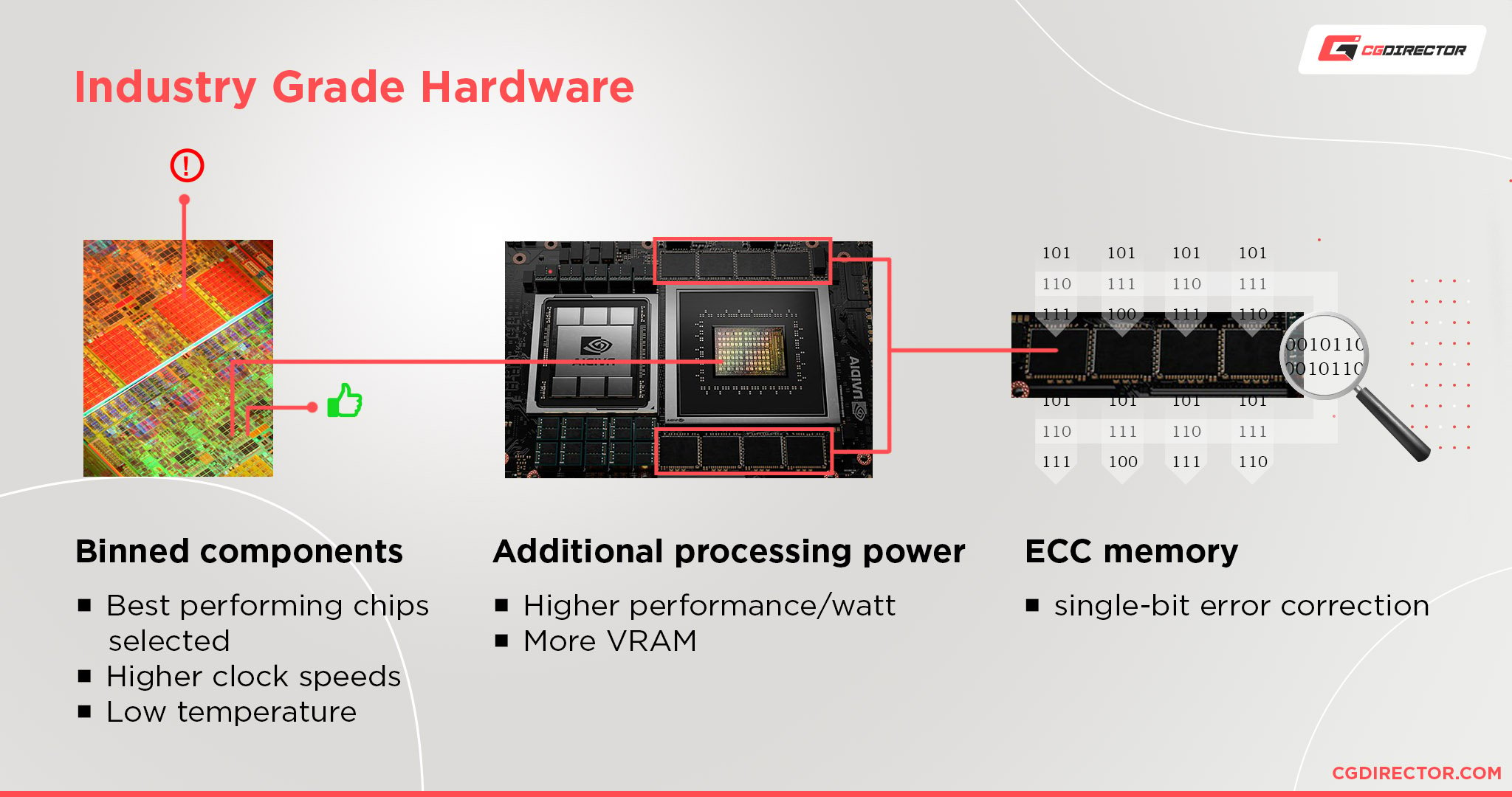
Each of these features translates into better stability and/or better performance for professional workloads. For example, having more PCIe lanes allows motherboards to support quad-GPU setups and several NVMe SSDs without sacrificing speed. Unfortunately, such powerful configurations are almost impossible to build using mainstream parts unless you’re compromising somewhere.
Workstation Definition
A workstation is basically a computer that has (at least one or more) ISV-certified, specialized hardware components, professional-grade software (which may include its operating system). It is designed for executing professional or scientific workloads.
Gaming PCs
OK, so we have a basic, general definition for workstations. What about gaming PCs?
When most think of gaming PCs, they imagine a flashing, rainbow-colored, illuminated box paired with equally flashy peripherals.
But despite the stereotype, many gaming PCs can also double as professional setups and perform tasks like video editing or 3D modeling just as well as their professional counterparts.
Gaming Demands
The reason why gaming PCs have become so versatile is partly due to how demanding gaming has become.
Sure, you can play less hardware-intensive online multiplayer titles like Counter-Strike or League of Legends at 1080p and 60 FPS even with older/cheaper equipment, but running modern AAA titles at 4K with 120 FPS will require a beast of a machine.
Versatile Hardware
And gamers won’t always just play video games.
They may also broadcast and promote their gaming achievements (and personality?) through platforms like Twitch or YouTube. This requires photo & video editing and/or streaming – which utilizes multi-core processing.
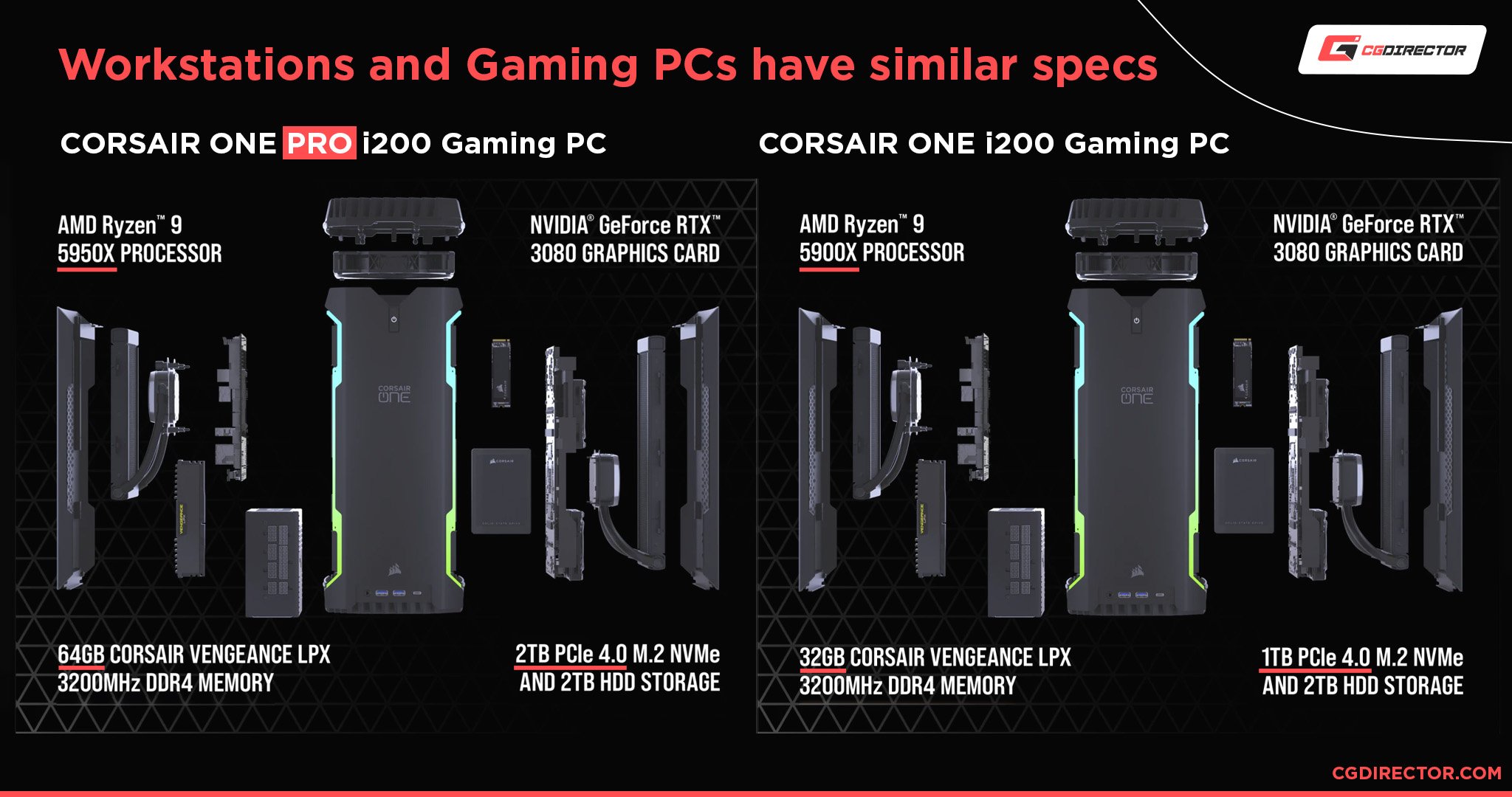
Also, add any multitasking that is often paired with gaming, like having a ton of browser tabs open or applications like Discord and XSplit/OBS running in the background.
Overall, you can’t compromise on the quality of any component when building a high-end gaming station in today’s market.
Consumer OS & Software
Gaming PCs are mostly marketed to individuals. As a result, the operating system and accompanying software don’t need to be as demanding (and expensive) as professional or enterprise variations.
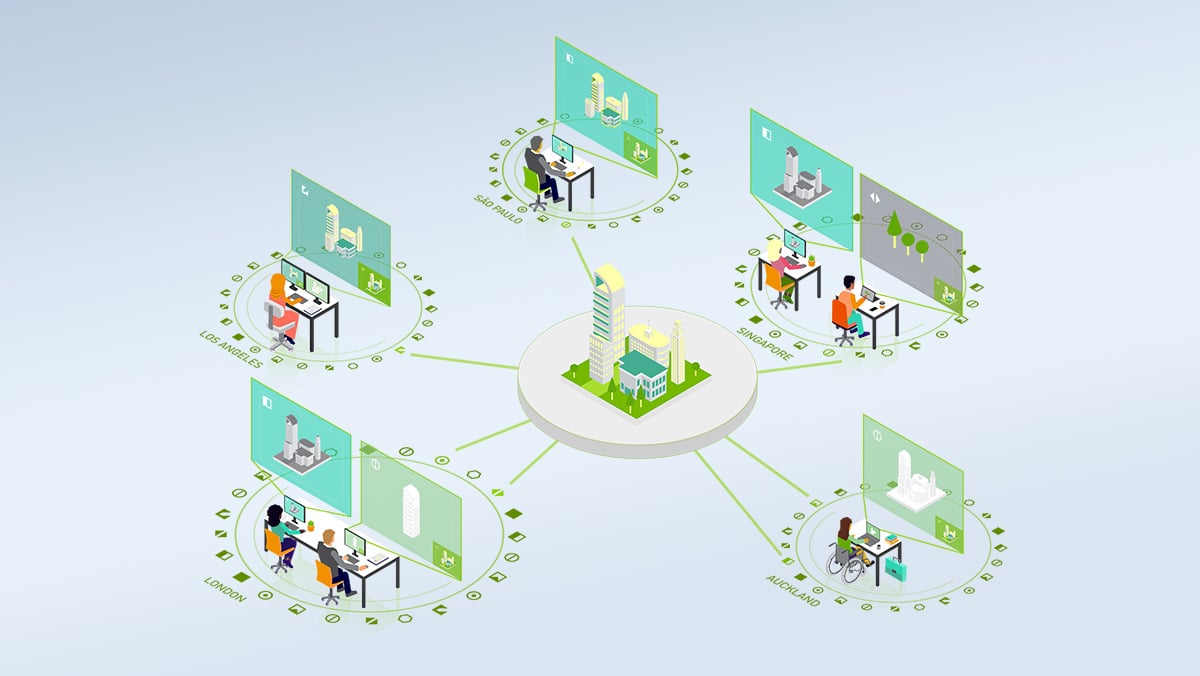
This doesn’t mean you can’t run professional software on a Gaming PC. It’s just isn’t typical for a gaming PC to have a host of active keys, follow unnecessary security standards & protocols, and have immediate 24/7 support.
The downside is that some applications will have certain features be incompatible with consumer-grade hardware, which can be detrimental to professionals who depend on those features for work.
Gaming PC Definition
A gaming PC can be defined as a computer with consumer-grade hardware and software, primarily built for gaming applications and basic everyday home use. However, it can also handle professional or scientific-grade workloads without too many hiccups.
Workstation vs. Gaming PC: What’s the Matchup Like?
You can’t have the word “versus” in the title without an actual square-off between the two. So, how do they fare when pitted against each other in professional workloads?
Performance
Depending on the workstation or gaming PC, the difference in performance can favor either side.
Generally speaking, a gaming PC will always have a better price to performance ratio when compared to a workstation.
Take, for example, the relative performance of the $5,700 Nvidia Quadro RTX 8000 versus the $700 GeForce RTX 3080, or the single-core Cinebench R20 results of the $5,500 AMD Ryzen TR 3990X versus the $329 Ryzen 7 3700X.
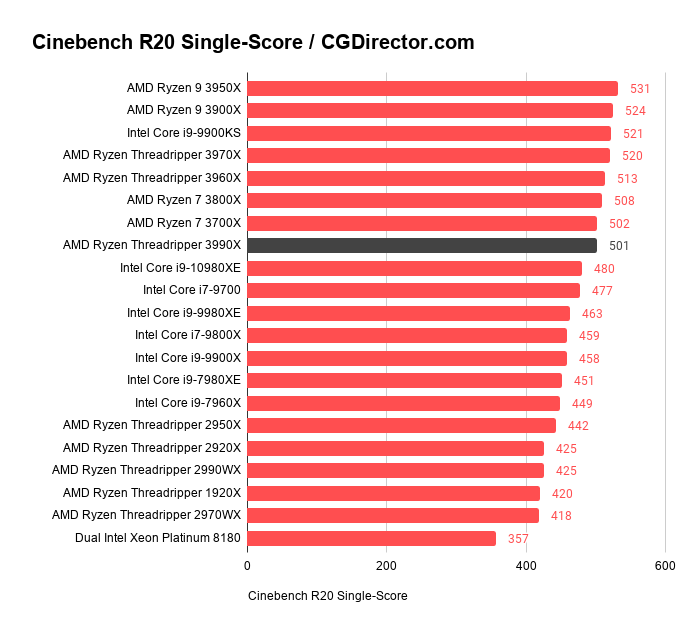
Threadripper 3990X – Cinebench R20 Single Core Score
To be fair, that can be a bit misleading because the Quadro RTX 8000 also has more than four times the amount of VRAM than an RTX 3080, and the TR 3990X has eight times more cores than the 3700X.
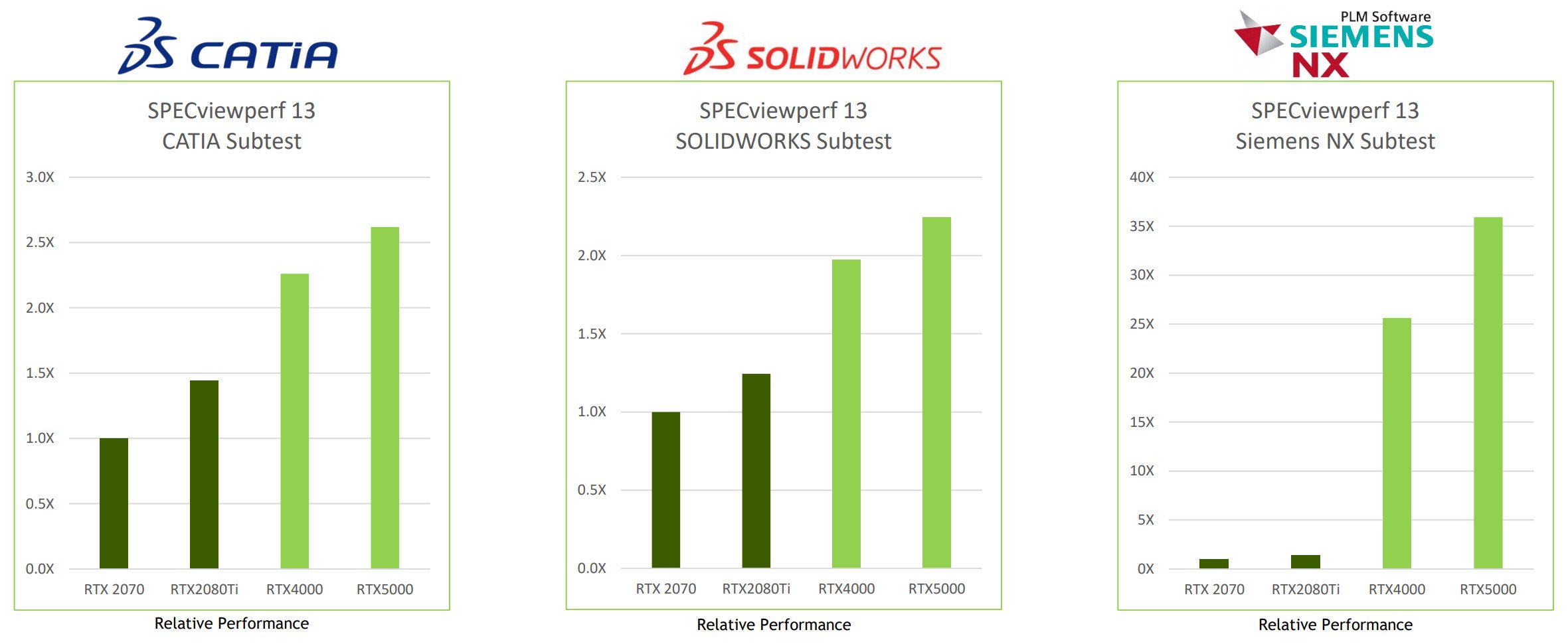
Still, overall, the value per dollar will always be higher for the mainstream parts, as they don’t come with higher-quality premium components, longer warranties, additional R&D for professional software compatibility, or ISV certifications.
Stability
When it comes to stability, workstations are built differently – literally.
Stability is one of the most important qualities for a workstation since disruptions can be an enormous waste of time. For example, imagine spending hours rendering a complex scene, only to crash at the last second. Hours and hours wasted.
On the other hand, if a gaming PC crashes or stutters, sure, it’s not pleasant, but it’s also not the end of the world.
Manufacturers of professional computer hardware components work closely with ISVs to ensure that their hardware is as stable as possible when running their applications.
Their hardware and software/drivers are also extensively tested to minimize any such instabilities.
Versatility
Modern high-end gaming PCs can do pretty much anything.
You can have a 16-core CPU with incredible single-core speeds, a GPU with 24 GB of memory, RAM that makes full use of the capabilities of DDR4, and lightning-quick PCIe Gen 4 NVMe SSDs – all in a Gaming PC.
Now, you may be thinking, why would a gamer need an expensive high-end PCIe Gen 4 M.2 SSD? That’s a good question, as it doesn’t really outperform cheaper Gen 3 models for gaming or light general use.
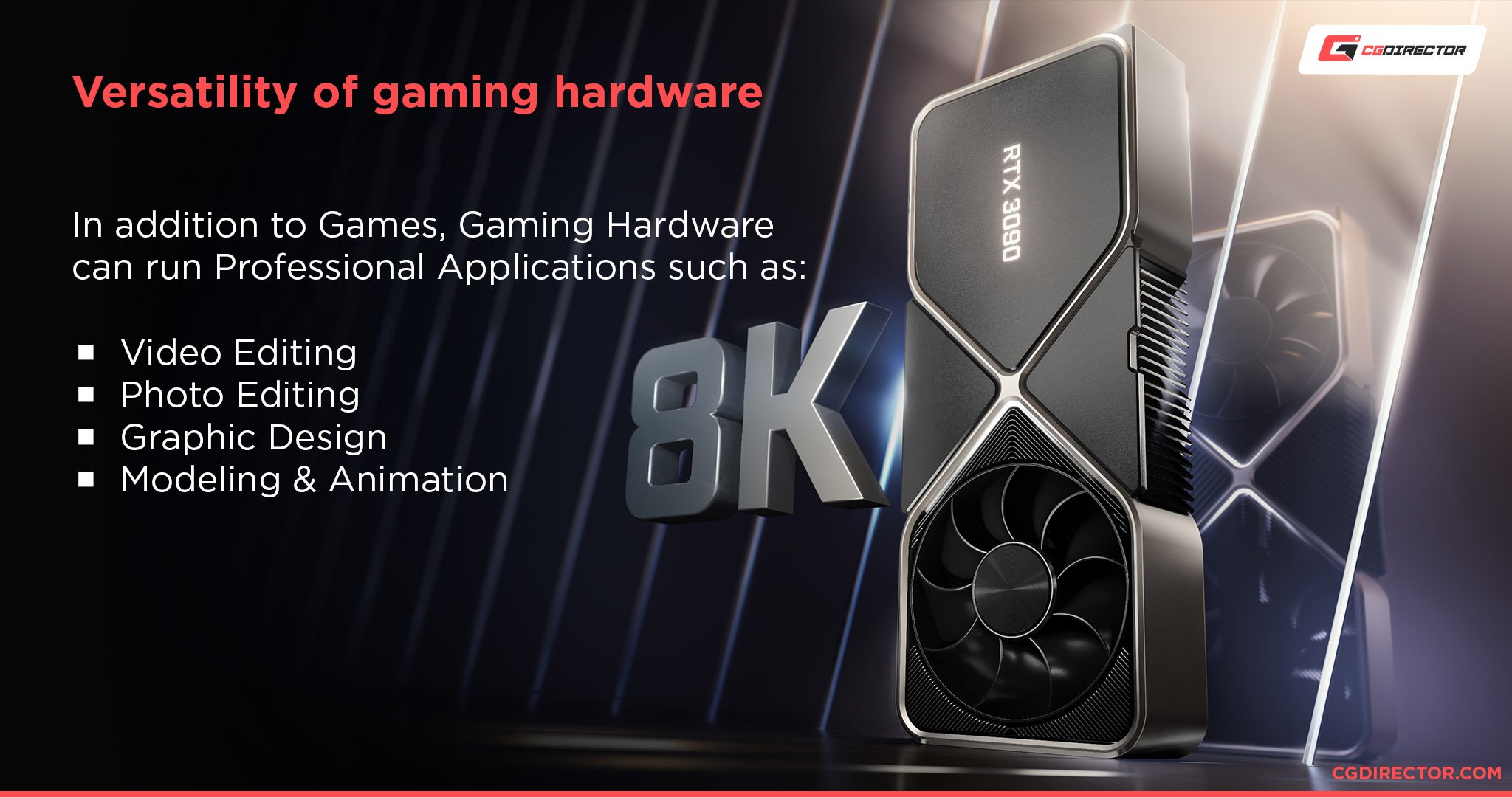
Still, many gamers will gravitate towards the latest, newest hardware in an attempt to ‘future-proof’ their builds. It’s basically a fancier way of saying they’d like to get whatever they can right now to extend the life of their Gaming PC before it needs an upgrade.
They can handle professional workloads quite well and will allow you to hop into a game to relax without compromising on performance anywhere.
On the other hand, having a workstation PC handle a gaming application will be a sub-optimal experience, at best.
You can have a workstation GPU that costs an order of magnitude more than a gaming GPU but actually falls behind it in terms of gameplay performance.
Reliability
Typically, workstations are built to last – which is less of a concern for gaming equipment.
Manufacturers create and market gaming hardware so that it’s upgraded frequently, offering new equipment on an almost yearly basis.
Overclocking the GPU, CPU, or RAM also doesn’t help their intended lifespan, which will vary depending on care and use.
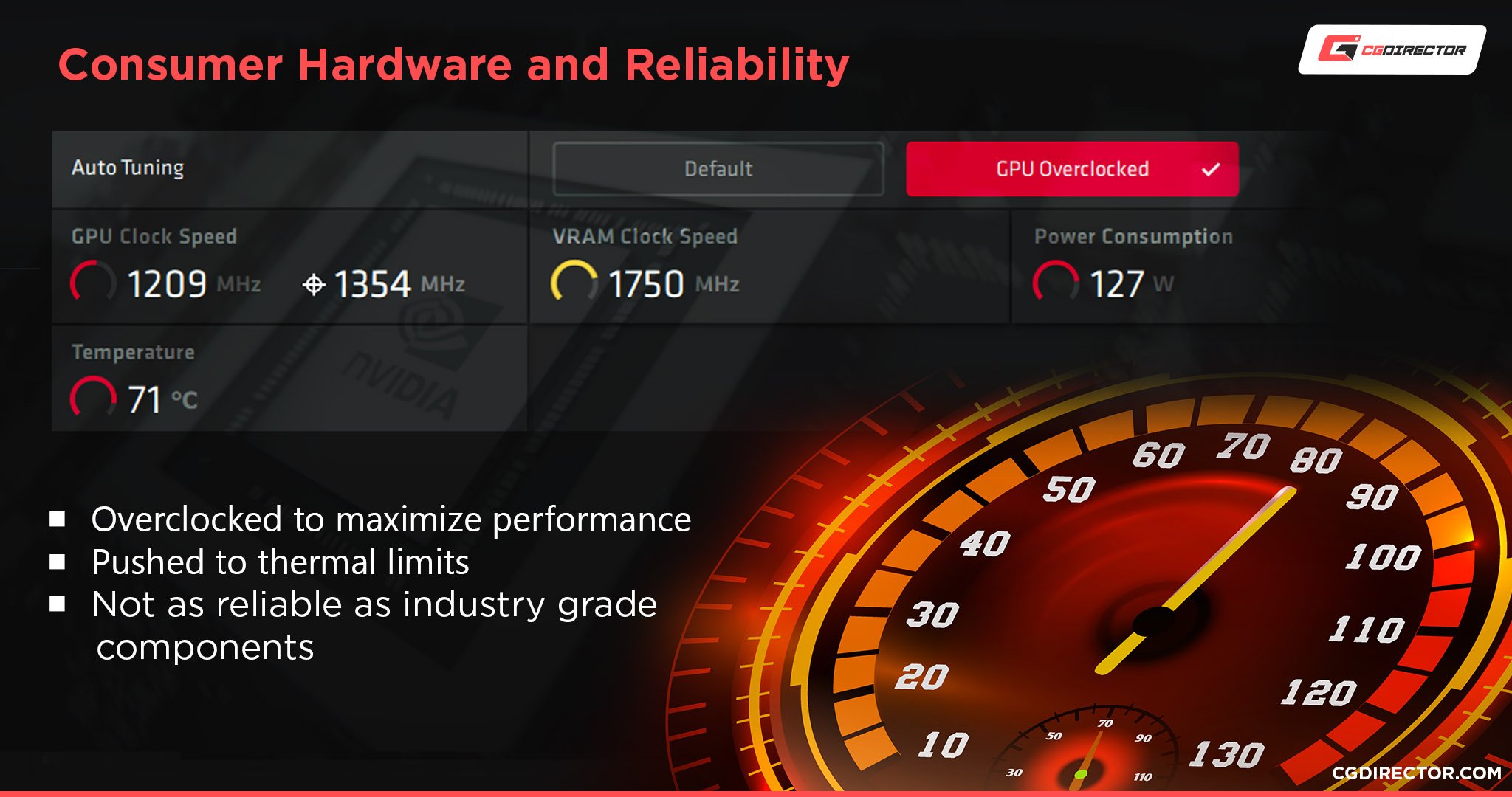
Professional hardware is built to be reliable because having a component fail prematurely can translate to a huge monetary loss for the customer – and the vendor will probably need to fix or replace the unit.
Price
As mentioned during the performance section, the price difference will be substantial.
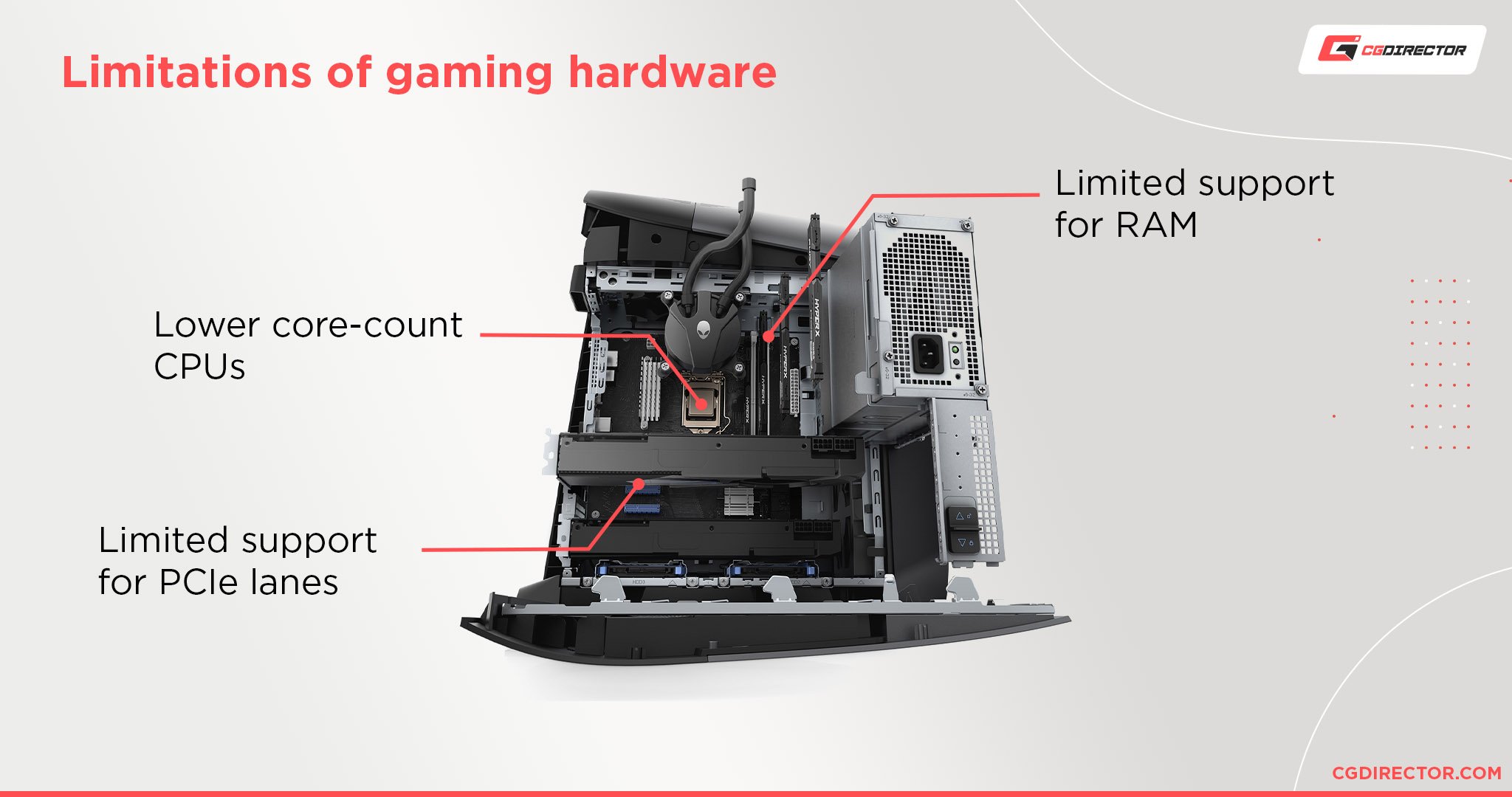
If you’re looking to build a PC on a budget or get the most out of every dollar spent, you should go for a gaming PC with the hardware your workloads will need.
Just make sure there are no deal breakers, like limited PCIe lanes, the lack of extended vendor support, or any potential missing software features.
Which Type Should You Buy?
The computer you build doesn’t necessarily have to fit every criterion listed in the definitions above, for workstations and gaming PCs.
If you custom-build your PC depending on your own specific needs, and don’t opt for a pre-built workstation/gaming PC, you can mix and match features as you need.
Do you need ISV certifications, or can you fix any potential issues that arise on your end?
Are minor crashes or regular updates disruptive for your workloads, or can you get through them unscathed?
If you don’t need the certifications and care little for drivers with longevity, or ECC memory, then chances are – you can opt for consumer hardware. Note – some mainstream platforms can offer professional features at times. Make sure you check!
Always confirm that the software you use, and the features within, are compatible with the hardware you’re purchasing.
On the other hand, if your workloads require input from multiple individuals, and you need to follow specific security guidelines, you may be better off allocating your resources for a professional-grade operating system or software.
FAQs
Is a Workstation a PC?
Yes, it is! A workstation can be a PC that’s designed for a specific workload/purpose.
Can a Laptop be a Workstation?
Of course. We even have an article that will help you choose the best workstation laptop for your needs.
Why Are Workstations So Expensive?
Mainly due to their professional components that include ISV development and certifications.
Add to this the additional research & development spent for software support, the optimized drivers, and the specialized hardware, and you can see why their prices are so much higher than mainstream parts.
Also, note that pre-built workstations can cost you far more money than building one yourself.
Are Workstations Worth It?
Most definitely so, for the right professional.
Workstations are investments, and people make those investments hoping that they will turn a profit – monetary or otherwise.
In essence, a workstation gives you the means to realize your own potential or carry out technical/scientific tasks that allow you to work and provide value to clients or your employers.
Are Gaming PCs Good for Production?
Gaming PCs can be compelling production tools.
It all depends on their hardware and the type of production you’re aiming for. They can work great for audio or video editing or even 3D modeling, for example.
Can You Game on a Workstation?
Absolutely. Depending on the type of workstation, that is.
Is it worth it? Absolutely not. You’ll get the gaming performance of a $500 consumer GPU while using a $5,000 Quadro.
It is also arguable whether or not it’s worth putting such expensive equipment through the wear and tear of long gaming sessions… but for a few games on the side: no harm, no foul.
Conclusion
Despite being somewhat obscure, the line between a workstation and a gaming PC allows you to distinguish one from the other.
Which one better suits your needs, or whether you should opt for a hybrid build, will ultimately depend on your needs and preferences.
When building a workstation, make sure you’re meticulous in your research because components are expensive, and you don’t want to overspend on the wrong parts.
The ultimate goal of PC building is picking parts that give you exactly what you need; nothing more, nothing less.
However, yes, this is easier said than done, but with the proper guidance – and plenty of patience – you, too, can build the workstation or gaming build that will run your applications to a T.
Over to You
What type of PC are you looking to build? Are you considering building a workstation or a gaming PC for work?
No matter what you’re aiming for, feel free to ask us for any help or recommendations in the comments below! You can also find several related threads in our expert forum, so make sure to check it out.
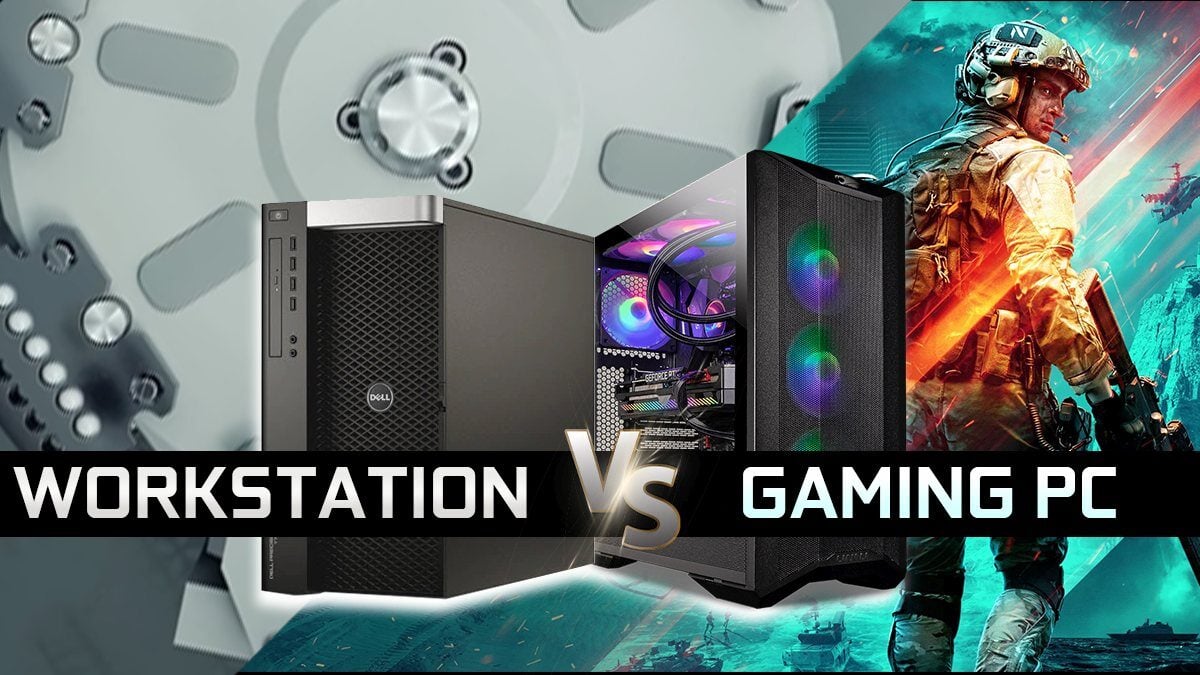
![Should You Build a PC? [7 Great Reasons] Should You Build a PC? [7 Great Reasons]](https://www.cgdirector.com/wp-content/uploads/media/2023/11/Should-You-Build-a-PC-7-Reasons-For-Building-a-PC-Twitter-594x335.jpg)
![Is GIGABYTE a Good Brand? [2024 Update] Is GIGABYTE a Good Brand? [2024 Update]](https://www.cgdirector.com/wp-content/uploads/media/2023/07/Is-GIGABYTE-a-Good-Brand-Twitter-594x335.jpg)
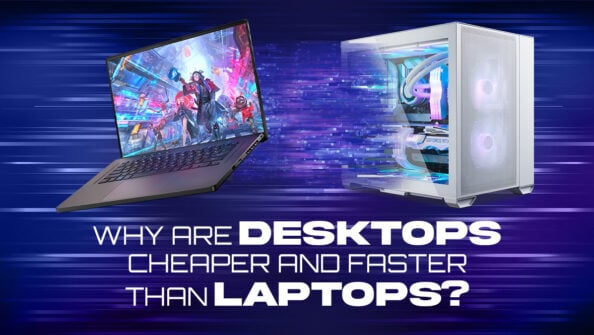
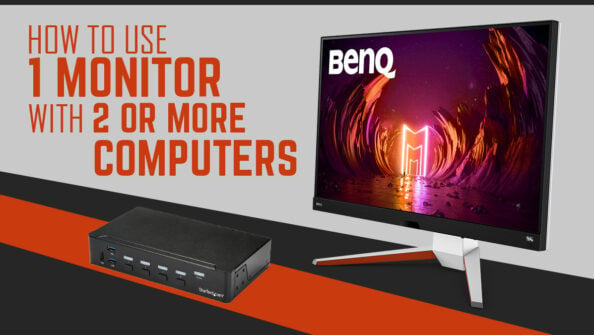

4 Comments
11 August, 2023
Are the UI of Adobe Photoshop and Lightroom more responsive on a workstation with a professional Quadro graphics card than on a gaming PC with a GeForce graphics card?
My gaming PC are not always running Photoshop and Lightroom at 120fps.
12 August, 2023
Hi klumpo! Neither Photoshop nor Lightroom are optimized for professional GPUs, and they’re also CPU reliant more than anything else. Having a good GPU will make these applications more responsive, but investing in a professional Quadro for either of them would essentially be a waste of money.
Are you experiencing any stuttering with Photoshop and Lightroom?
22 July, 2023
I just contacted them asking if I should buy a gaming or workstation before reading this. Now I feel dumb.
18 January, 2023
This is such good advice! And it gives me comfort to know another writer who doesn’t write systematically same amount of time each day.